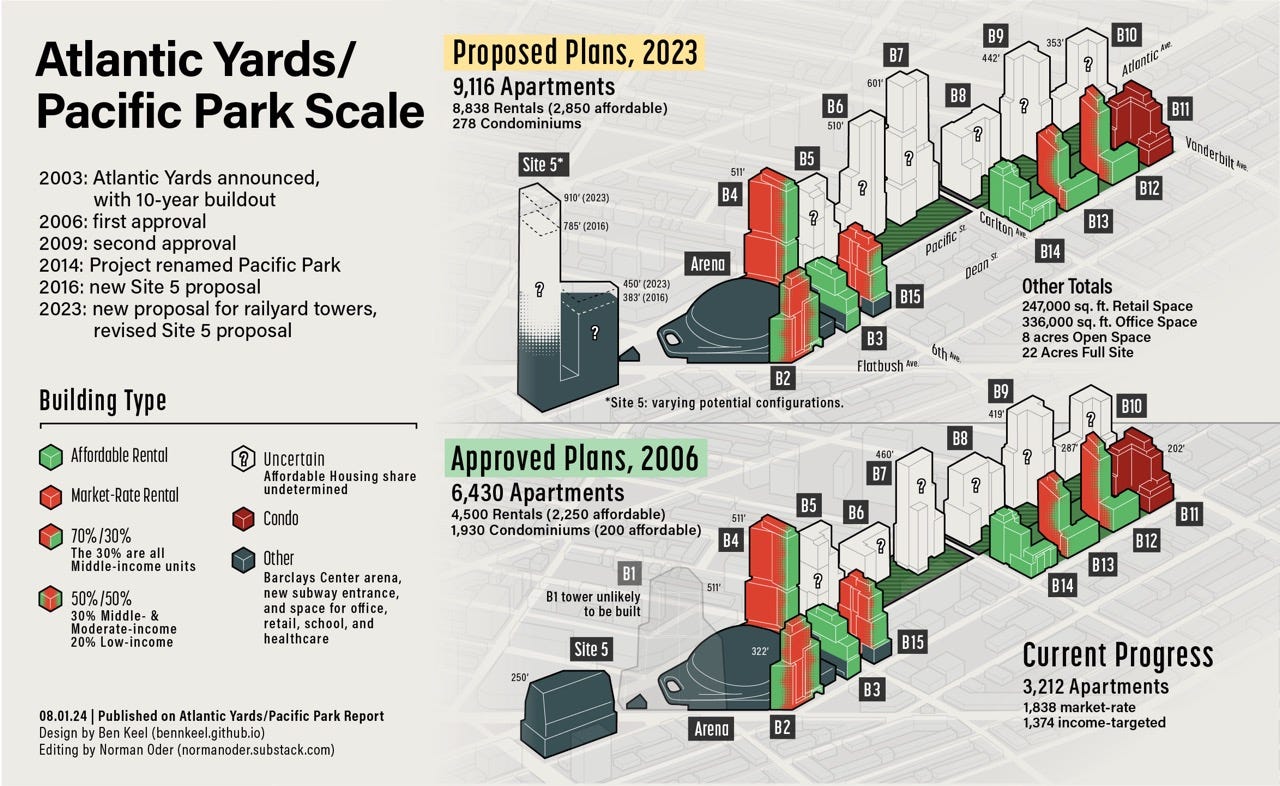How's Ticketmaster Plaza outside Barclays Center leased? State officials unsure of terms. But "temporary" plaza could be renegotiated, given arena value boost.
This is the second of three articles about the Aug. 8 Atlantic Yards Community Development Corporation (AY CDC) meeting. The first concerned the mystery topic discussed in Executive Session. The third concerned plans for Site 5 and community engagement about the project's future.
Late in the meeting, AY CDC Director Gib Veconi brought up an issue related to the plans for Site 5, which involve moving the bulk from the unbuilt flagship tower once slated to loom over the arena (B1, aka "Miss Brooklyn") across Flatbush Avenue to create a giant, two-tower project at the parcel currently occupied by the big-box stores P.C. Richard and the now-closed Modell's."We believe so, we'd have to double-check," responded Kolkmann.
"It'd be nice to see an outline," observed AY CDC Chair Daniel Kummer, of the site boundaries and the public sidewalk.
Veconi moved that there be a presentation at the next AY CDC meeting. Though there was no pushback, the discussion went in a different direction, so it never came to a vote. Still, it's not unlikely there would be a presentation.
Director Ron Shiffman suggested looking at whether the plaza could be transferred to a public entity like the Parks Department or the Department of Transportation. ("Why not map it as parkland and charge a licensing fee?" I've argued.)
"If it's under a lease," Kummer cautioned, "that transfer would have to be subject to the lease."
The urban plaza shall be completed and available for public use upon the date of the opening of the arena. Thereafter, [developer Forest City] shall operate and maintain the urban plaza in good and clean condition, until such time as the area occupied by the urban plaza is required for construction of Building 1 or the Urban Room.That’s repeated in a 2014 update to the document, a Second Amended Memorandum of Environmental Commitments.
(a) The Parcel B-1 Occupant shall notify the Arena Parcel Occupant at the time that it has determined that it is ready to proceed with (i) the construction of Building B-1 and or (ii) the modification of the public amenity comprising a plaza and other facilities in the portion of the Arena Parcel adjacent to Flatbush and Atlantic Avenues (the “Urban Experience”) into the permanent glass-enclosed urban room contemplated by the MGPP (the “Urban Room”) (such notice, a “Construction Notice”)....(i) No later than thirty (30) days after the receipt of a Construction Notice... the Arena Parcel Occupant shall designate a portion of the Arena Parcel and or the Arena Block (Non-Arena Parcel) Interim Lease Premises as the location for a temporary box office, other Arena facilities or portions of the Arena and/or entrance(s) for the Arena
(a) ESDC hereby grants to and establishes in favor of the Parcel B-1 Occupant a permanent, non-exclusive easement for the benefit of the Parcel B-1 Occupant and its Permitted Users for ingress to and egress from Building B-1 through the Urban Experience or, when constructed, the Urban Room (said Urban Experience or Urban Room, as applicable, the “Urban Zone"), subject to the following conditions:(i) The Arena Parcel Occupant shall have the exclusive right to occupy any portion of the Urban Zone... as a box office or other related uses..., including without limitation, for a café, restaurant, retail and/or other service uses, the exclusive right to license the naming of the Urban Zone and any portions thereof, the exclusive right to install and ‘maintain signage in the Urban Zone and the right to retain all other economic interests derived from the Urban Zone not expressly granted to the Parcel B-1 Occupant in this Declaration.
Except as explicitly stated otherwise in his Declaration, the Arena Parcel Occupant shall have the right to use and benefit from the Urban Zone as it sees fit, in is sole discretion, provided that such use does not affect the rights of the Parcel B-1 Occupant expressly granted in this Declaration in more than a de minimis fashion; provided that the Arena Parcel Occupant shall not configure or place obstructions in the Urban Zone in a manner that materially interferes with ingress and egress to Building B-1
Yes, the arena operator, currently Tsai's BSE Global, has invested in the parcel, for example in 2022 revamping the worn pavers and light fixtures, and belatedly installing outdoor--rather than the promised indoor--bike parking.
But that document was nonbinding, and ESD ignored that pledge. Nor did any elected officials raise the issue when Tsai bought the WNBA’s New York Liberty and moved them to Brooklyn.



Comments
Post a Comment